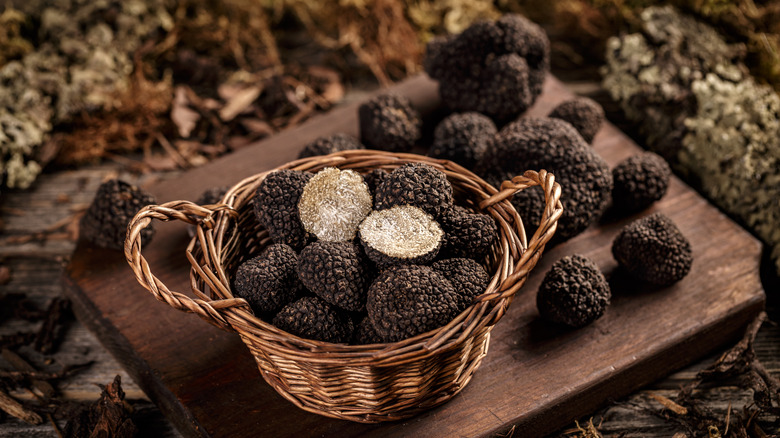Truffles, the gastronomic treasures hidden beneath the earth’s surface, have captivated human senses and palates for centuries. These elusive fungi, celebrated for their intoxicating aroma and distinctive flavor, embody a harmonious marriage of nature’s complexity and culinary excellence. From their mysterious origins to their cultural significance and ecological impact, truffles continue to intrigue and inspire, leaving a lasting impression on those fortunate enough to experience their rare allure.
Origins and Varieties
Truffles belong to the genus Tuber and come in several prized varieties, with the most renowned being the white truffle (Tuber magnate) and the black truffle (Tuber melanosporum). Each type carries its own distinct characteristics shaped by the unique terroir where it grows. White truffles, notably found in the forests of Italy’s Piedmont region, exude a pungent aroma with notes of garlic and shallots, while black truffles, flourishing in France’s Périgord region, offer a rich, earthy fragrance with hints of chocolate and nuts. These regional nuances contribute to their culinary desirability and economic value.
Culinary Excellence
Renowned chefs worldwide covet truffles for their ability to elevate dishes to extraordinary heights. Whether shaved over pasta, risotto, or scrambled eggs, or infused into oils and butters, truffles impart a luxurious depth of flavor that enhances the simplest of ingredients. Their earthy, umami-rich profile pairs seamlessly with a range of foods, from seafood and poultry to vegetables and cheeses, offering endless possibilities for culinary creativity. Truffles symbolize indulgence and refinement, gracing the tables of Michelin-starred restaurants and gourmet kitchens alike.
Harvesting and Foraging
The pursuit of truffles is a centuries-old tradition steeped in mystery and skill. Traditionally aided by trained dogs or pigs, truffle hunters navigate dense forests in search of the elusive fungi. Truffles grow underground in symbiotic relationships with the roots of specific trees, such as oaks and hazelnuts, requiring precise techniques to locate and harvest without damaging the delicate mycelium. This delicate process ensures the sustainability of truffle cultivation, preserving their natural habitats for future generations.
Economic Significance
Beyond their culinary allure, truffles hold substantial economic importance for regions where they thrive. The annual truffle markets of Alba, Italy, and Périgueux, France, attract enthusiasts and traders from around the globe, where bidding wars ensue for the finest specimens. This economic activity supports local communities and cultural traditions, highlighting truffles as a pillar of regional identity and prosperity. The cultivation and trade of truffles sustain livelihoods and stimulate tourism, showcasing their profound impact on both local and global economies.
Scientific Intrigue
Scientifically, truffles continue to fascinate researchers for their unique biology and ecological roles. Their symbiotic relationship with trees, facilitated by intricate mycorrhizal networks, enhances soil health and ecosystem biodiversity. Genetic studies and environmental research contribute to understanding truffle growth patterns and improving cultivation techniques. As climate change and habitat degradation pose threats to truffle populations, scientific inquiry plays a crucial role in conservation efforts and sustainable management practices.
Conservation Challenges
Despite their cultural and economic significance, truffles face conservation challenges stemming from habitat loss, climate change, and unsustainable harvesting practices. Efforts to preserve truffle habitats and promote responsible harvesting techniques are essential for ensuring their long-term viability. Conservation initiatives seek to balance economic interests with environmental stewardship, fostering a sustainable future where truffles thrive in harmony with their natural surroundings.
Cultural Reverence
Truffles occupy a revered place in culinary traditions and cultural celebrations across Europe and beyond. Festivals dedicated to the truffle harvest, such as Alba’s Fiera del Tartuffe and Périgueux Salon International du Chocolate, showcase local craftsmanship, gastronomy, and folklore. These events not only celebrate truffles as a symbol of luxury and culinary excellence but also reinforce their cultural heritage and community pride. Truffles serve as a testament to human ingenuity and appreciation for nature’s gifts, fostering connections between people and their environment.
Future Perspectives
Looking ahead, the future of truffles hinges on sustainable practices and innovative technologies. Advances in cultivation techniques, including controlled environments and mycorrhizal research, offer promising avenues for increasing production while minimizing environmental impact. Global demand for truffles continues to rise, driven by evolving consumer tastes and a growing appreciation for natural, artisanal foods. As stewards of the land, producers and researchers collaborate to ensure the continued success and conservation of truffles, preserving their legacy for future generations to savor and cherish.
In conclusion, truffles stand as a testament to nature’s culinary artistry and human ingenuity. From their mysterious origins in the depths of the earth to their global allure as a gourmet delicacy, truffles embody a rich tapestry of flavors, traditions, and ecological significance. As we navigate the complexities of sustainability and conservation, truffles remain a symbol of cultural heritage and gastronomic excellence, inspiring admiration and fascination across borders and generations.
